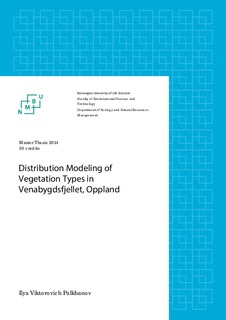| dc.description.abstract | This study explores the effect of increasing sample units density with
presence-only data (PO data) on the ability to predict the distribution of three
common (2e dwarf shrub heath, 4b bilberry birch forest and 9c fen) and
three rare (3b tall forb meadow, 8d rich swamp forest and 9d mud- bottom
fens and bogs) vegetation types.
The chosen study area was Venabygdsfjellet in Ringebu municipality,
Oppland. In 2001 the vegetation in the study area was mapped by Norwegian
Institute for Forest and Landscape. The vegetation map was used as material for
the PO data in the prediction modeling. In beforehand, this map was quality
assessed. To evaluate the quality of the map, necessary fieldwork and statistical
analysis was conducted. As a result of this evaluation, 84 % of all observations
correspond to the mapped distribution on the vegetation map. The PO data for
distribution modeling were collected in a point grid with different densities (100
m for common and 25 m for rare vegetation types) within the sample units
(1500×600m size). The sample unit was equivalent to a Primary Statistical Unit
(PSU) of the AR18×18 survey system and given in a grid net with five
densities: 3×3 km, 4,5×4,5 km, 6×6 km, 7,5×7,5 km and 9×9 km. In addition to
PO data, 12 environmental variables were used as explanatory predictors (the
digital elevation model, basin, curvatures, flow accumulation, flow direction,
groundwater, slope, satellite image, the Normalized Difference Vegetation
Index (NDVI), the Topographic Wetness index (TWI), sediment and soil maps).
Using the PO data and these environmental variables, each vegetation type was
modeled in all five densities of the PSU grid using a maximum entropy
modeling method using a custom-made software called MaxEnt.
In total, 26 out of 30 planned prediction models were run. The four
missing models did not have any PO-points in some of the PSU grid density.
Out of 26, 23 prediction models performed well according to the AUC-measure
provided by MaxEnt (> 0.80 AUC). The statistical comparison of the predicted
and true distribution of the modeled vegetation types showed that only 7
prediction models can be considered as good (2e in densities 3×3 km and
4.5×4.5 km, 4b in densities 3×3 km and 4.5×4.5 km, 9c in densities 3×3 km and
7.5×7.5 km and 3b in density 3×3 km). The vegetation types 8d and 9d were not
modeled successfully any PSU grid densities, although they had high AUCvalues.
The best modeled vegetation type was 4b in a 3x3 km PSU grid density.
The variable importance analysis conducted by MaxEnt trough the Jack-Knife
test, showed that the DEM (the digital elevation model), NDVI index (the
Normalized Difference Vegetation Index), slope and satellite images in blue
band were the most important environmental variables among all vegetation
type models. | nb_NO |
